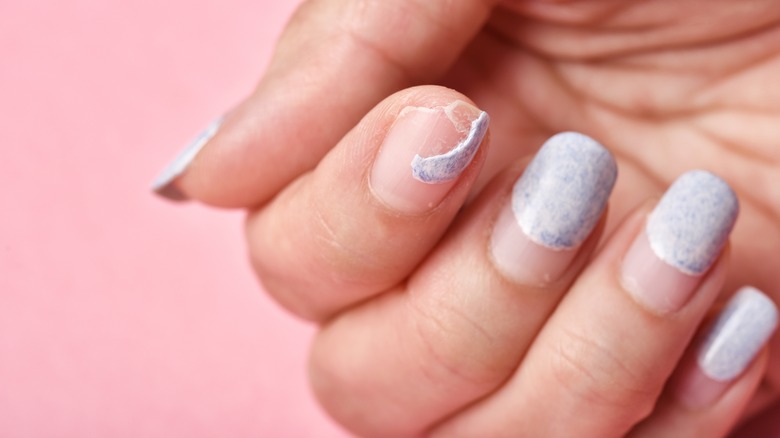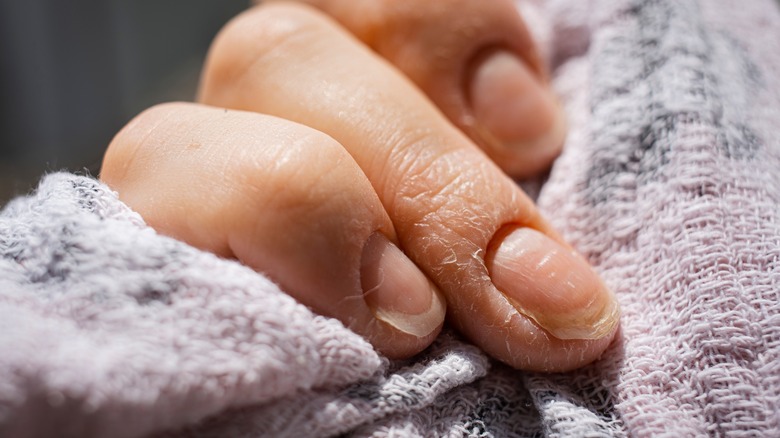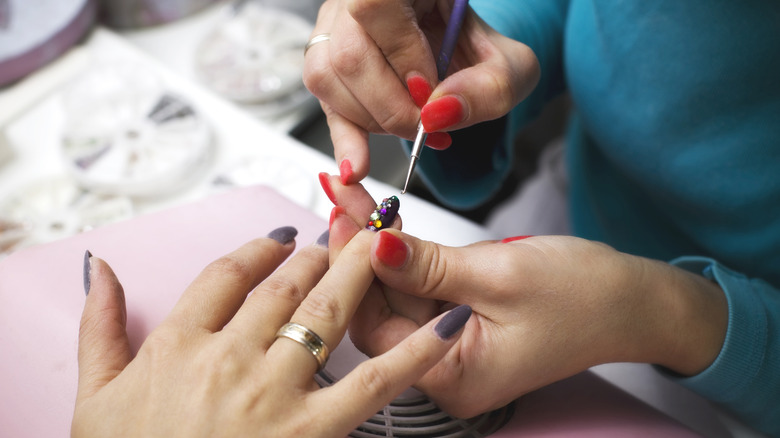You're Not Imagining It - Your Manicures Don't Last As Long In The Winter. Here's Why
The cold winter months can be rough on our bodies. Staticky hair, flaky skin, and chapped lips are among the most common winter beauty woes. But perhaps the worst of all is noticing chipped, brittle nails soon after getting a fresh manicure. Manicures typically last between seven and 10 days (or up to three weeks for gel manis, per Easy Nail Tech), but you might start noticing wear and tear after just a couple of days in the winter. We know — it's a bummer.
If you look down at your nails and notice a peeling, cracked mess, you could throw on your warmest gloves to hide them and call it a day. But chances are you didn't get your nails done just to conceal them from the world. Instead, learn why winter is so hard on nails in the first place. Then, follow these tips to extend the lifespan of your manicure.
Winter sucks the moisture out of your nails
In the summertime, your manicures are strong and long-lasting. So why are they so weak in the winter? One of the biggest culprits is a lack of moisture, according to experts. "With colder temperatures, there is less humidity in the air, causing dryness," dermatologist Ella Toombs told NailPro. "And nails that are dry tend to fracture and break more easily." Besides the nails themselves, look to the surrounding cuticles and skin on the fingers for cracking, inflammation, or ashiness. These are all signs that your hands could use some TLC. Apply lotion often and swipe on cuticle oil once per day.
Especially during cold and flu season, washing your hands regularly is a must, but do keep your nails in mind. Overexposing dehydrated nails to water (as well as harsh soaps) can wreck your mani, according to Dr. Dana Stern, a dermatologist and nail disorder specialist. "The nails are 1000% more absorptive of water than the skin," Dr. Stern explained to Refinery29, "and so the influx of water will put a lot of strain on the nail cells." This can lead to breakage and peeling, causing polish to crack and flake easily.
Extreme temperatures and polish don't mix
Windy weather and frigid temperatures can lead to nail dryness, but that's not the only way harsh weather can affect your mani. It turns out that your polish also doesn't respond well to winter conditions, especially when exposed to cold air outdoors and hot air indoors. "Those large fluctuations in temperature and humidity cause the polish on your nails to expand and contract, and it is this flux that causes polish to lift, separate and chip," Dr. Dana Stern shared with Refinery29.
Similarly, polish stored at toasty temps breaks down and becomes discolored more quickly. Some even store nail polish in the refrigerator. If you — or your salon — tend to keep nail products in warm rooms or, even worse, near a radiator or heater vent, you might notice your manicures don't last very long.
If your polish does begin to chip, resist the urge to peel the rest off — you might actually peel the top layer of your nail off with it. Instead, remove the remaining pigment carefully with a nail polish remover.
Your go-to manicure may not work in the winter
Between dehydration and harsh weather, your nails have to work extra hard during the winter season. Therefore, they may need a break from some of your favorite manicure designs and nail care products. Amy Ling, the founder of the nail salon and polish brand Sundays, told Coveteur, "Gel [and acrylic are both] heavier on the nail bed and [don't] allow your nails to breathe as much." On that note, long manicures leave nails vulnerable to breakage, especially in the winter.
Does this mean you're better off skipping a mani entirely? Not quite. In fact, polish can help you get stronger and healthier nails. "Nail polish prevents water from being absorbed and therefore can be protective," Dr. Dana Stern revealed to Bustle. "It also binds the nail cells together, so nails are less likely to fray and split." When choosing polishes, go for non-toxic versions when possible, and skip harsh ingredients to keep nails strong. When it's time to remove your design, avoid acetone nail polish remover, which can worsen dryness and damage.



